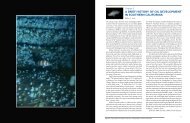checklist (pdf) - The Love Lab - University of California, Santa Barbara
checklist (pdf) - The Love Lab - University of California, Santa Barbara
checklist (pdf) - The Love Lab - University of California, Santa Barbara
Create successful ePaper yourself
Turn your PDF publications into a flip-book with our unique Google optimized e-Paper software.
Carcharhinus leucas (Müller & Henle, 1839). Bull Shark. To 3.5 m (11.5 ft) TL (Compagno et al. in Fischer et al.<br />
1995). Circumglobal in warm waters; possibly southern <strong>California</strong>; southern Baja <strong>California</strong> (Eschmeyer<br />
and Herald 1983) to Paita, Peru (Chirichigno 1974), including Gulf <strong>of</strong> <strong>California</strong> (Compagno et al. in<br />
Fischer et al. 1995). Also found in fresh water. At less than 1 m to 152 m (499 ft; Compagno 1984).<br />
Carcharhinus limbatus (Müller & Henle, 1839). Blackfin Shark or Blacktip Shark. To 2.5 m (8.2 ft) TL<br />
(Compagno et al. in Fischer et al. 1995). Circumglobal in tropical waters; Ensenada, northern Baja<br />
<strong>California</strong> (Ebert 2003) to northern Peru (Chirichigno and Vélez 1998), including Gulf <strong>of</strong> <strong>California</strong><br />
(Compagno et al. in Fischer et al. 1995) and Islas Galápagos (Grove and Lavenberg 1997). Unconfirmed<br />
records from <strong>California</strong> (Ebert 2003). Inshore (Compagno 1984), surface (Grove and Lavenberg 1997)<br />
to 64 m (210 ft) (Crow et al. 1996).<br />
Carcharhinus longimanus (Poey, 1861). Oceanic Whitetip Shark. Maximum length variously listed as<br />
between 3.5 and 3.95 m (11.5 and 13 ft) TL (Compagno 1984). Circumtropical; unconfirmed reports<br />
from central <strong>California</strong> (Ebert 2003), perhaps Gaviota, southern <strong>California</strong> (T. Herrlinger and P. Krause,<br />
pers. comm. to M. L.) and Cortes Bank, southern <strong>California</strong> (Miller and Lea 1972), to Puerto Pizarro,<br />
Peru (Chirichigno 1974), including Gulf <strong>of</strong> <strong>California</strong> (Compagno et al. in Fischer et al. 1995) and Islas<br />
Galápagos (Grove and Lavenberg 1997). At or near surface to about 200 m (656 ft) (min.: Eschmeyer<br />
and Herald 1983; max.: Boggs 1992).<br />
Carcharhinus obscurus (Lesueur, 1818). Dusky Shark. To at least 3.7 m (12.1 ft) TL, possibly to 4.2 m (13.8 ft)<br />
TL (Ebert 2003). Circumglobal; Redondo Beach, southern <strong>California</strong> to Gulf <strong>of</strong> <strong>California</strong> (Eschmeyer<br />
and Herald 1983) and to Ecuador (Béarez 1996). Surf zone to 400 m (1,312 ft; Compagno 1984).<br />
Carcharhinus porosus (Ranzani, 1840). Smalltail Shark. To 3.4 m (11.4 ft) TL (Compagno in Carpenter<br />
2003). Western Atlantic and eastern Pacific; southern Baja <strong>California</strong> (Compagno et al. in Fischer et al.<br />
1995) to Callao, Peru (Compagno 1974), including Gulf <strong>of</strong> <strong>California</strong> (Compagno et al. in Fischer et al.<br />
1995). At 16–32 m (50–105 ft; Compagno et al. in Fischer et al. 1995).<br />
Galeocerdo cuvier (Péron & Lesueur, 1822). Tiger Shark. To 5.5 m (18 ft) TL, possibly to 7.4 m (24.4 ft) TL<br />
(Randall 1992). Circumglobal in tropical waters; sighting (unverifiable) at Prince William Sound, Gulf<br />
<strong>of</strong> Alaska (Karinen et al. 1985); southern <strong>California</strong> to Peru (Eschmeyer and Herald 1983), including<br />
Islas Galápagos (Grove and Lavenberg 1997) and Gulf <strong>of</strong> <strong>California</strong> (Galván-Magaña et al. 1996). Coastal<br />
pelagic; surface and intertidal area to at least 350 m (1,148 ft; Ebert 2003) and perhaps to 800 m (2,625 ft;<br />
<strong>Lab</strong>oute and Grandperrin 2000); prefers waters turbid with freshwater run<strong>of</strong>f (Compago 1984).<br />
Nasolamia velox (Gilbert, 1898). Whitenose Shark. To 150 cm (59 in) TL (Compagno et al. in Fischer et al.<br />
1995). Central Baja <strong>California</strong> and Gulf <strong>of</strong> <strong>California</strong> (Compagno et al. in Fischer et al. 1995) to Puerto<br />
Pizarro, Peru (Chirichigno and Vélez 1998), including Gulf <strong>of</strong> <strong>California</strong> (Compagno et al. in Fischer et<br />
al. 1995) and Islas Galápagos (Grove and Lavenberg 1997). At 15–192 m (49–630 ft; Compagno et al. in<br />
Fischer et al. 1995).<br />
Negaprion brevirostris (Poey, 1868). Lemon Shark. To about 3.4 m (11.2 ft) TL (Compagno 1984). Pacific<br />
and Atlantic; Bahia Magdalena, southern Baja <strong>California</strong> (Galván-Magaña et al. 2000) and Gulf <strong>of</strong><br />
<strong>California</strong> (Compagno 1984) to northern Peru (Chirichigno and Vélez 1998). Intertidal area and to<br />
92 m (304 ft) or more (Compagno in Carpenter 2003).<br />
Prionace glauca (Linnaeus, 1758). Blue Shark. To 383 cm (12.6 ft) TL, reported but not confirmed to 4.8–<br />
6.5 m (15.7–21.3 ft) TL (Compagno 1984). Circumglobal in temperate and tropical waters; in western<br />
Pacific as far north as southern Kuril Islands (Savinykh 1998); Kodiak Island, western Gulf <strong>of</strong> Alaska<br />
(Karinen et al. 1985) to Chile (Miller and Lea 1972), including Gulf <strong>of</strong> <strong>California</strong> (Compagno et al. in<br />
Fischer et al. 1995) and Islas Galápagos (Grove and Lavenberg 1997). Oceanic pelagic, typically over<br />
water depths greater than 183 m (600 ft) but <strong>of</strong>ten venturing near shore (Compagno 1984); surface to<br />
about 350 m (1,148 ft) (min.: Eschmeyer and Herald 1983; max.: <strong>Lab</strong>oute and Grandperrin 2000).<br />
8




